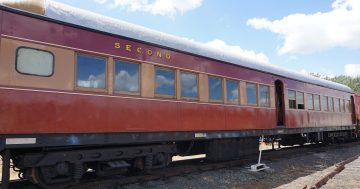
The 5917 on Good Friday between Bungendore and Queanbeyan. Photo: Ben Murch.
In James’ earliest memory, he is standing on the platform at Katoomba Station in the Blue Mountains. The steam clears to reveal a sacred “triple-header”, three hulking great locomotives all hitched up in a row, a symphony of hissing and clanking.
“It just blossomed from there,” he says.
James Rumble is one of two NSW Trainlink drivers based here in the ACT. On the Easter weekend and again this Anzac weekend, he’s on board “The Picnic Train”, carrying beaming families between Canberra and Bungendore with the old-fashioned power of steam.
His primary role is that of “pilot driver”. The steam train driver and fireman might be qualified for their roles, but they also require someone who knows the track. And there isn’t much track in NSW and the ACT James doesn’t know.

James Rumble at the helm of a steam locomotive. Photo: Ben Murch.
He decided to turn his childhood passion for trains into a job and, by 2008, he was at the wheel of a coal train in the Hunter Valley.
From there, he volunteered to work at one of Australia’s most iconic infrastructure projects, the Zig Zag railway near Lithgow in NSW, before moving into mainline heritage with the NSW Transport Museum. He’s been with The Picnic Train for four years now.
Last weekend was the first time a steam locomotive has run on ACT tracks since 2018, and James says passion for them is still burning hot.
“It’s been a complete sell-out for the five days we’ve been running over these two long weekends,” he says. “It’s been amazingly successful. The reaction from people in the capital region has been insanely good.”
Despite the piercing whistle, he says the overwhelming majority of locals are very happy to see (and hear) a steam locomotive powering through their backyard again.
The Picnic Train itself is a 1952 D59-Class Mikado steam locomotive used by the NSW Government Railways from the 1950s until the end of steam operations in the 1970s. It was originally built in the US but was imported to NSW and converted to run on oil due to a coal shortage at the time. Once the situation improved, the power source reverted back to what it is today – coal.

The Picnic Train climbing Molonglo Gorge on Easter Sunday. Photo: Ben Murch.
Compared to the modern experience, James describes driving a steam train as “very labour intensive”.
“It’s one of the reasons railways got rid of them to begin with. You have to be physically fit to drive them and then obviously, you have to shovel all that coal into them.”
Steam trains also cost “many, many thousands of dollars” to run.
“You’re talking eight to nine tonnes of coal a day, plus all the water and maintenance hours that have to go into them. For every hour of running, there are many more that go into maintaining them.”
To top it all off, trains pay an access fee to use the track, in much the same way as motorists pay registration or tolls.

James Rumble feeding the beast. Photo: Ben Murch.
The Picnic Train is linked to Sydney Rail Services, but the ACT’s fleet of old trains is managed by the not-for-profit company Capital Region Heritage Rail (formerly Australian Railway Historical Society), which also runs the Canberra Railway Museum in Kingston.
One of these trains, a 1954 6029 Beyer-Garratt steam locomotive, was christened ‘City of Canberra’ in 2015 by then-Speaker of the ACT Legislative Assembly, Shane Rattenbury. Only two years later, however, ARHS went into liquidation and the train was sold into private hands. It is currently stored at the NSW Rail Museum in Thirlmere.
James says that slowly but surely, the museum is working to bring its other two trains, the 3016 and 1210, back on track.
“The popularity of The Picnic Train has definitely proved there’s an appetite for that in the ACT,” he says.
From 1993 to 2006, ARHS also operated the Michelago Tourist Railway between Queanbeyan, Royalla and Michelago, now at the centre of a feasibility study that would have it converted into a recreational cycle trail.
James agrees that the 208 km of disused track has almost certainly seen its last train.
“It will cost tens of millions of dollars to get something as far as Royalla going again. It’s not out of the question, but there is a lot of infrastructure work that would need to happen.”
Nothing else steam-powered is on the ACT’s calendar this year, but James says The Picnic Track will be back “judging by the huge success”.





















